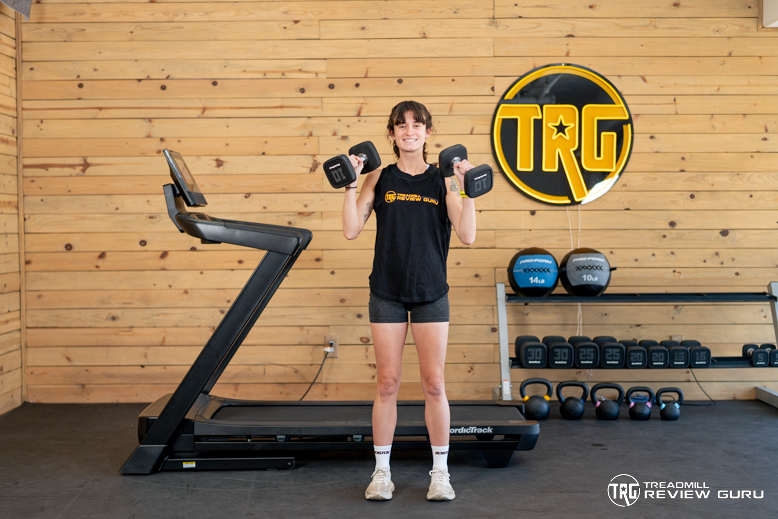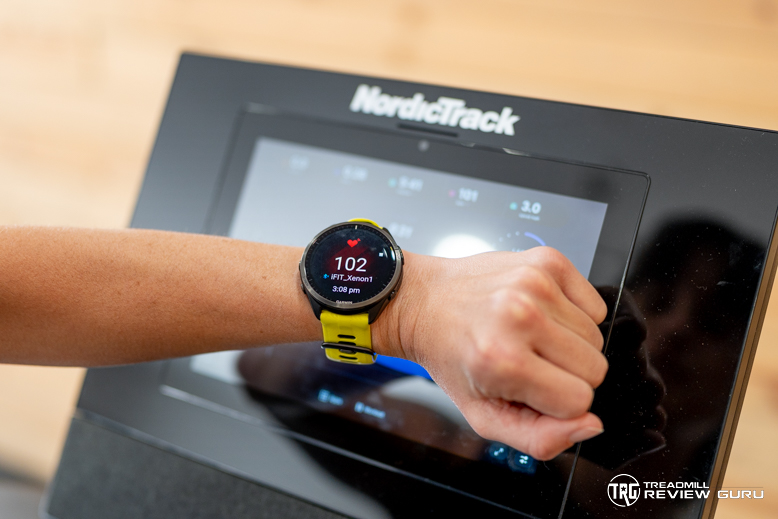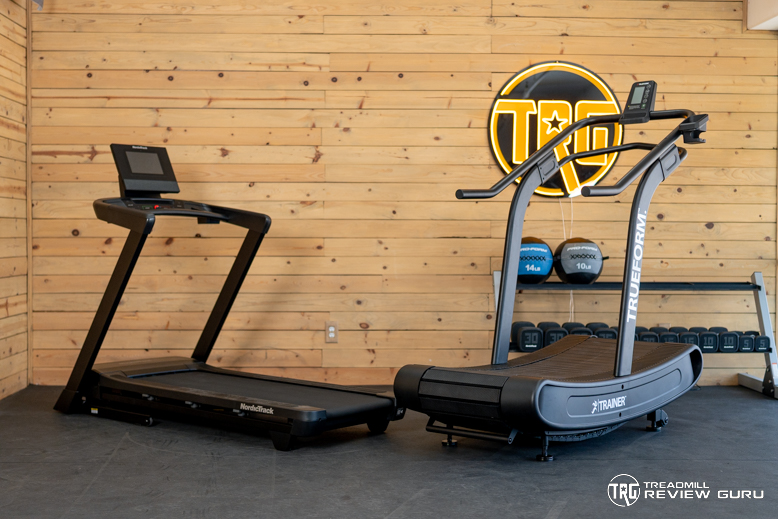As an exercise physiologist, I know there are numerous methods for improving fitness and building cardiovascular endurance, in particular. Yet, walking is one of the simplest and most accessible options. It’s one of the most natural forms of exercise we can do.
In this post, I will cover all the benefits of walking so you can get inspired or stay motivated to walk regularly. Thirty minutes of walking per day is a great goal. Let’s learn more about why and how to do it most effectively.

Caloric Burn Rate

Many treadmills track your calorie burn, but remember, these estimates may not be entirely accurate.
Walking on a treadmill aids weight loss by helping you create a caloric deficit. A caloric deficit means you are consuming fewer calories than you burn per day. Keep in mind that there are tons of variables that will impact your exact calorie burn. Fitness trackers and equipment use different equations to estimate your calorie burn, but they may not be accurate.
During a thirty-minute walk, you could burn between 100 and 150 calories when walking around 2.5 miles per hour. This estimate uses the average weight of an American woman and man input into an equation for caloric expenditure. If you walk at a different speed, weigh more or less, or have a fast or slow metabolism, your calorie burn may be quite different.
Adding a 5% incline to your walk at 2.5 miles per hour takes the estimated calorie burn up to 200 calories or more. Alternatively, you can increase your speed. Walking at 4 miles per hour at a flat incline gives you an estimated calorie burn of 160 calories or more, depending on your weight.
As you lose weight, you will burn fewer calories. To continue to burn more calories, you will need to increase your speed, incline, or time spent walking. You can also add a weighted vest for an extra challenge.
Using our calorie estimates, we find that walking for thirty minutes every day can burn one to two pounds per month. Walking for an hour per day can burn over three pounds per month. If you keep this habit up for a year, you could lose twenty to forty pounds in one year from walking alone. (Note: a pound of fat is 3500 calories)
Video
Walking Isn’t Enough

For the best weight loss results, consider more than just the amount of walking you do.
Though walking daily is great, it’s important to give your body a break when necessary. If you need to take a rest day every week to recover, that’s okay and important for your health. Walking isn’t the only factor in weight loss, and it may not be the most important factor either. There are many things you can do if you are taking an off day from your dedicated walking workouts.
You can keep your weight loss goals on track by eating a healthy diet. Nutrition is the most important component of weight loss. While the focus of this post isn’t on nutrition, this is an important principle to remember.
Strength and Cross Training
There are many other forms of cardio if you do not enjoy walking. Cycling, swimming, rowing, and using the elliptical are other options. All of these exercise options can lead to weight loss. You can also supplement your walking routine by incorporating these other activities on the days you don’t walk. This is called cross-training.
Cross-training allows you to work additional muscles or change the load on the muscles you are using. It is a great way to stay active, even when you are taking a break from walking.
Strength training is also a crucial component of weight loss, as building muscle mass can increase the number of calories you burn throughout the day and while walking. Add weight lifting into your routine two or three times a week for even better weight loss results.
Stress and Weight Loss
While strength training and walking will help you lose weight, it’s important to realize that you can’t choose where you lose that weight from. Many of us would like to burn belly fat first, but for many individuals, that isn’t what happens.
Belly fat can be hard to lose if you have high cortisol levels. Cortisol is a hormone released in your body due to stress. Regular exercise, such as strength training and walking, can help reduce your stress levels. This reduction in stress may help you lose belly fat over time.
Walking lowers stress and can improve your mood. It releases chemicals in your brain that make you feel good, which can improve symptoms of depression and anxiety. While starting a regular walking routine can feel daunting at first, it should feel good and boost self-esteem.
How to Implement a Walking Routine

A heart rate monitor can be a helpful tool for implementing an effective walking routine for weight loss.
To get the most out of walking, it’s important not to push yourself too hard too fast. If you are not currently exercising, you can start with short walks of five to ten minutes. Increase your walking time as your walks become more manageable.
It’s okay if walking feels challenging or makes you feel sore. Soreness (especially after walking on an incline) is normal. You can take a rest day or two if necessary, but try not to let more than two days pass to maintain a consistent walking routine.
If you are tracking the number of steps you walk per day, you can build up your fitness by increasing your daily step count by ten to twenty percent at a time. Make this increase every week to progress your fitness.
Heart Rate
Walking increases your heart rate. This is normal and nothing to be concerned about, as your heart rate needs to increase during exercise to bring more blood and oxygen to your muscles. Because your heart rate increases as your workout intensity increases, it’s a good measurement of workout intensity.
You can use your treadmill’s heart rate pulse grips or a heart rate monitor to track your heart rate.
To know that you are in the right heart rate zone, calculate your maximum heart rate. Subtract your age from 220. That’s a good estimate of your maximum heart rate. For example, if you are 40 years old, your maximum heart rate is around 180 beats per minute.
You don’t want to train at your maximum heart rate except in very specific circumstances. On most days, try to stay in Zone 2 for your heart rate. Zone 2 is 60 to 70% of your maximum heart rate. If you find that your heart rate tends to be in Zone 3 during your walks, that’s okay. It may lower as you become more fit.
For a 40-year-old with a maximum heart rate of 180, a Zone 2 heart rate is between 108 and 126 beats per minute. Zone 3 spans 127 to 144 heartbeats per minute for the same individual. It is 70 to 80% of your maximum heart rate. It’s okay if you end up training in this zone more often, but you want to at least be in Zone 2.
You should target Zone 2 because it improves your cardiovascular system. It is a higher effort than you would hit if you were walking around your home or office. But it is not too difficult.
When you work at a higher intensity than Zone 2, your body uses carbohydrates from your blood, muscles, and liver as energy. In Zone 2 or lower, your body uses mostly fat. Walking slowly may be more effective than walking fast for burning fat for this reason.
Walking in Zone 2 is particularly important if you are working out before breakfast or in a fasted state. If you walk at a higher intensity while in a fasted state, your body may burn more protein or muscle for fuel. This occurs when the body attempts to burn carbohydrates for fuel, but there are insufficient carbohydrate stores in the body to support exercise. Keep your exercise intensity lower if you are working out when fasted.
Zone 3 and Higher
Walking at a fast speed adds an extra challenge to your workout. Do faster walks after you have eaten a meal. Push into Zone 3 or 4 of your heart rate for fast, high-intensity intervals. Use incline or a higher speed to get into this harder zone. Harder workouts burn more calories. Even if your body uses more carbohydrates for fuel, it will still burn fat, too.
High-intensity workouts are essential for improving your cardiovascular fitness. Even if your goal is weight loss, you should still prioritize your whole body health.
Tips for Staying Consistent While Avoiding Injury

Working on your walking form and correctly warming up for each session can help you reduce your injury risk.
Improving your health can lead to better weight loss results. As you become more fit, you can walk for longer and faster, increasing your caloric burn. You will also need fewer rest days as you recover from workouts faster.
Growing stronger and fitter can lead to you feeling better, which can help you stick to an exercise routine. However, it is still important to rest, even as your fitness improves. Overtraining puts you at an increased risk of injury. Nothing derails a fitness routine or weight loss program like an injury.
Learn to listen to your body to tell the difference between general muscle soreness and injury. If something doesn’t feel right, rest and treat the injury. Whenever you feel pain that could prevent you from walking, you should always address the root cause in addition to resting. That will help you get back on your feet and into your routine faster!
If you have pain while walking, it’s important to ensure that you have the proper equipment as a first step. You shouldn’t use old shoes. Use fresh shoes that still have cushioning and support. Your shoes should be made for exercise, not casual shoes.
Gait Retraining
It’s also important to ensure that your walking form is correct. If you have a limited range of motion in your hips, knees, or ankles, it could cause you pain while walking. You could also see problems if you lack sufficient strength or balance.
If you suspect that you are struggling with one of these problems, it is best to consult a qualified specialist who can help you. A physical therapist, personal trainer, or coach can help correct your walking mechanics. Developing good walking form is important whether you are walking outside or inside.
Choosing a Treadmill

A manual treadmill is up to 40% harder than a motorized treadmill, increasing your calorie burn.
To walk at home, you may need a treadmill. A good walking treadmill will have a powerful motor (2.5 to 3.5 HP), a high weight capacity (300 lbs or more), and a long warranty. A treadmill with a 10-year frame and motor warranty or longer is best.
A good range of speed and incline features allows you to get more out of each walk and progress your fitness. A top speed of at least 4 miles per hour is best for walking for fitness. An incline of 10 to 12% is also helpful for adding intensity to your walks.
Walking on a treadmill is a low-impact activity. A treadmill is more cushioned than walking on the concrete outside, which could relieve pain in your joints. It’s also lower impact than running on the treadmill. Even if you plan to run once your fitness improves, walking is a good way to get started and puts you at a lower risk of injury.
Treadmill Training Content
As for training, some treadmills have built-in walking programs that will automatically adjust your speed and incline. These programs are great for beginners. They add variety to your training and keep you working at a good intensity.
Other treadmills have subscription programs that require a monthly payment to use. These programs are more complex. They provide better entertainment and coaching. Many of these services also have workout series that can help you progress your fitness over a few weeks. I recommend this training style for walkers who enjoy this type of content, have the budget for the monthly investment, and who could benefit from additional workout guidance.
How Much Should You Walk
A goal of walking for 30 minutes per day is a great goal. Even if you have to start with shorter walks, you can work up to 30 minutes. The American College of Sports Medicine recommends getting 150 minutes of moderate exercise per week. That’s five days of walking for 30 minutes per week.
If you want faster weight loss or more health benefits, targeting 200 to 400 minutes of exercise per week may be even better. This means walking for up to an hour seven days per week. You could also replace some of that walking time with cross-training to reduce your injury risk.
If you are tracking steps instead of minutes of walking, a common recommendation is 10,000 steps per day. While this is a great goal, you can also see benefits from walking fewer steps. Gradually increasing the number of steps you are taking from where you are at right now is okay. Try ten to twenty percent increases.
Walking ten thousand steps is about five miles. If you are walking at 2.5 miles per hour, this would take you two hours to complete. However, you don’t have to count only the number of steps you take during your workout. You can train on the treadmill for thirty minutes to an hour. The rest of your steps can be from your daily routine. If your regular routine does not require much walking, you may have to get creative to increase your step count.
Try taking mini walking breaks during the workday. Park further away from the store and other locations. Take the stairs instead of the elevator when possible. Under-desk treadmills can also be helpful if you are very busy and want to get some steps while you are working. Pair an under-desk treadmill with a standing desk to achieve your daily step goal. Use these tips to increase the amount you walk per day.
When to Schedule Your Walk
Walking first thing in the morning requires you to walk at a low intensity to target weight loss while in a fasted state. It can be a great way to start your day feeling energized. Walking after meals can be helpful for lowering your blood sugar.
Evening walks are also a good option. It can help you decompress after a stressful day. However, be sure to give yourself plenty of time between exercising and trying to go to sleep. Exercising too close to bed can leave you feeling restless.
Conclusion
Now that you know when to walk, what equipment you need, and how to upgrade your treadmill, you’re all set to start your walking weight loss journey. Remember that walking alone isn’t the key to successful weight loss. Incorporate strength training and improve your diet for the best (and fastest) results.


Leave a Reply